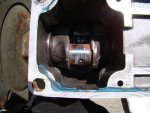stupid question, whats RTV
Room Temperature Vulcanizing Silicone Sealer. Spooge gasket. It comes in a toothpaste tube or a cheeze whiz can, and in just about any color you can think of. Often mistaken by do-it-yourselfers as an acceptable solution to sourcing a replacement gasket. Often mistaken by do-it-yourselfers as a way to "help" gaskets seal. causing gaskets to fail, resulting in more liberal use of silicone (or complete omission of the gasket) the next time around and further supporting the notion that gaskets don't work and RTV is a miracle cure, since RTV by it's self is (typically) more reliable than a gasket that's been pretty much ruined by smearing RTV all over it.
Generally a good thing to have around, but best left in the back of the toolbox to use when it's appropriate, but not in the front of the toolbox as a front line weapon against leaks. With a few exceptions, if it's beneficial for something then a specific type of RTV will be called for. That specific type should be used. Kind of like engine oil, most people want to know which one is best so they can use it for everything, and discussion of specific properties and qualifications of any particular type or color is pretty much prohibited from internet discussion.
I'm slamming on the stuff pretty hard, but I will say that there's a few exceptions where RTV is quite acceptable as a substitute. Axle flange gasket replacement comes to mind. Of course there's nothing wrong with the gaskets either. But RTV silicone works exceptionally well here. But if you want to move to the high risk category for axle flange bolts loosening up and breaking in shear... Grease that new gasket up with a layer of silicone to "help" it make a better seal...
For most of the things it gets used for in the real world... Well.... It must have worked just fine, because I don't see an oil leak complaint to go with the pictures above...

And if what you're sealing up doesn't have an oil passage through the middle of where the gasket is, consider the other picture. Compressor failure didn't disturb that gasket, and that chunk didn't make it through the compressor's oil passages. (nor did "the other chunk" apparently). That chunk came straight off of a joint somewhere all by it's self, presumably at the compressor base but possibly anywhere else in the engine that the same sealer was used.





